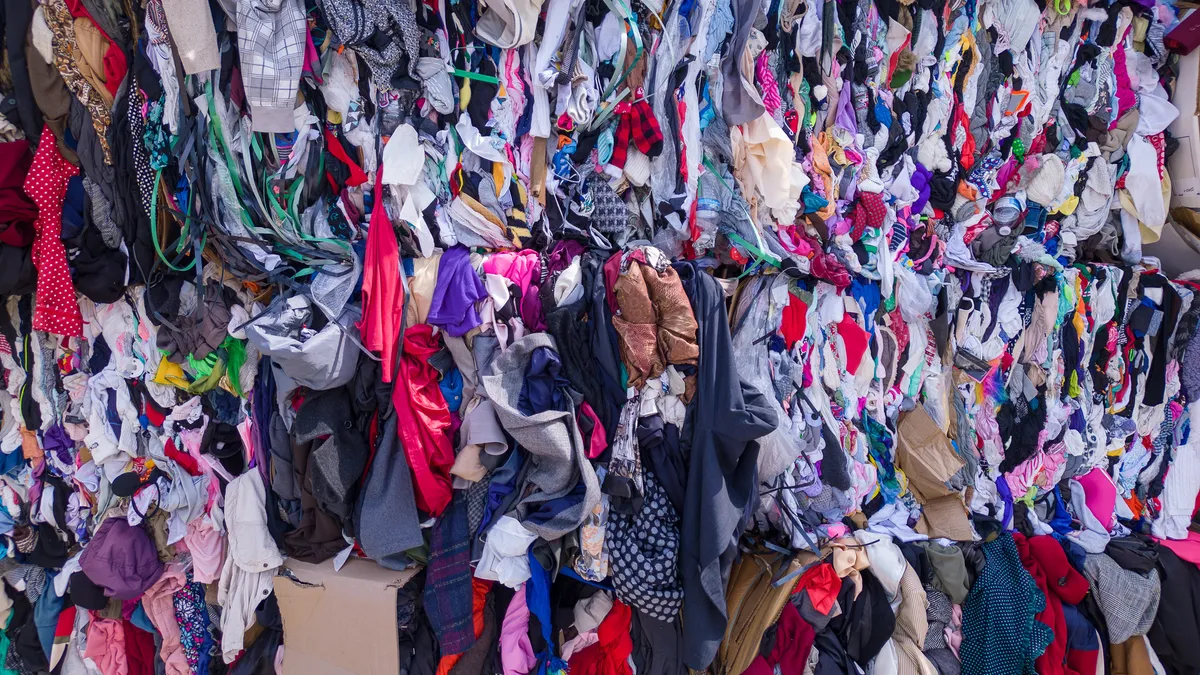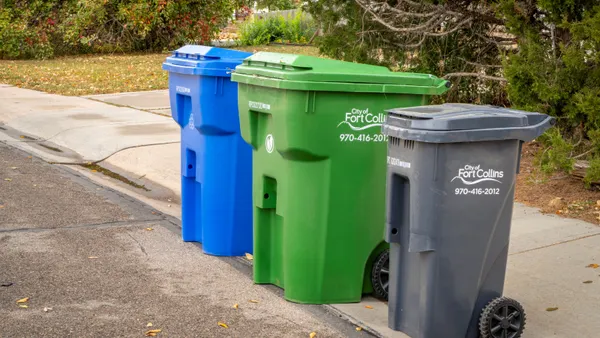Dive Brief:
- Recycling and waste groups in California expect to see fewer textiles enter their facilities in the coming years now that the state has passed a first-in-the-nation extended producer responsibility program for the material.
- CalRecycle is expected to begin the regulatory process, including hosting stakeholder meetings, as early as the first quarter of next year, said Joanne Brasch, director of advocacy and outreach at the California Product Stewardship Council, a main bill sponsor. That will keep the state on track to offer more options for recycling, repairing and reusing old clothing and textiles by 2030, she said.
- SB 707, signed by Gov. Gavin Newsom earlier this week, is also meant to take aim at the environmental impacts of fast fashion and “throwaway culture,” said bill sponsor state Sen. Josh Newman in a statement. Newman said the law “isn’t just about recycling; it’s about transforming the way we think about textile waste.”
Dive Insight:
Textiles are the fastest-growing category of residential and commercial waste in the state, according to the CPSC. Textile waste can also create specific issues at waste and recycling facilities.
“Textile and clothing producers over-produce hard-to-manage materials that can absorb, tangle, and combust if mixed into plastic recycling system[s],” said a coalition of waste groups, local governments and brands in an August letter. They also hope success in California could mean similar EPR programs elsewhere in the country.
Currently, most of the labor and cost of managing textile waste falls on thrift stores and secondhand markets, along with local governments, CPSC said.
The new law will hold textile producers, including major brands, financially responsible for managing such material at end of life. That could include funding convenient drop-off locations around the state, said Brasch.
The law will require producers of certain apparel and other textile products to establish a producer responsibility organization, which will fund statewide programs for reuse, repair and recycling.
CalRecycle will need to approve a producer responsibility organization by March 1, 2026, then adopt regulations to implement the program no earlier than July 1, 2028. The PRO will need to submit a plan for collection, repair and recycling of such textiles by July 1, 2030.
The law also calls for brands to emphasize repair and reuse programs, such as by partnering with an organization that repairs branded clothing for resale, Brasch said. Producers who prioritize repair aspects may also pay lower fees into the EPR program since the law sees repair programs as part of the ecomodulation process. “Repair is source reduction,” she said.
Numerous waste and recycling groups supported the bill, including Republic Services, Recology, GreenWaste, local chapters of the Solid Waste Association of North America, National Stewardship Action Council, Californians Against Waste, Resource Recovery Coalition of California and a coalition of brands and environmental groups.
Robert Reed, public relations manager at Recology, said in an email that textiles are “a growing waste issue” led by the rise of fast fashion. “More of these materials are ending up in our landfills and environment than ever before,” he said.
The new EPR model “brings clothing producers on board to improve collection and diversion, displace raw material needed to create new fabric, and reduce the environmental impact of the textile and fabric industry,” he said.
Bill supporters expect the textile EPR success in California to spark other state legislatures to consider their own versions of the bill — possibly in New York, where a similar bill did not move forward last year. Lawmakers at the federal level have also called for more in-depth solutions for textile waste across the country.
Meanwhile, Massachusetts has a disposal ban on textiles, which is different than a full EPR program but signals policy movement in that state.
Brasch said CPSC has already been talking with lawmakers and advocates in other states about their process. Doug Kobold, CPSC executive director, said the topic of textile EPR came up numerous times at a recent EPR event he attended in Canada.
Coalition building was an important aspect that allowed the bill to pass in California, Kobold said, and he hopes other states considering their own EPR for textiles bill can follow California’s example.
The bill was first introduced during California’s 2023 legislative session and passed the Senate. However, it was converted into a two-year bill to update language and accommodate more stakeholder input, including from retailers and the apparel industry that had originally opposed elements of the bill. Over the summer, the American Apparel & Footwear Association, which had previously opposed the bill, offered a more neutral stance, citing improved stakeholder engagement from bill sponsors.
“The advocates that have been working on this issue for years deserve a lot of credit for building a consensus around tackling textile waste,” said Nick Lapis, director of advocacy at Californians Against Waste, which supported the bill.
Long-term, Lapis said he hopes the law will help prompt producers to invest in “more sustainable design decisions from the outset. I, for one, am ready for more slow fashion.”
This story first appeared in the Waste Dive: Recycling newsletter. Sign up for the weekly emails here.










